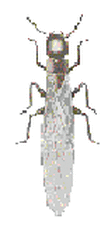Termites
Termites evolved from the cockroach over 150 million years ago and can be found in 49 of the 50 states -- everywhere except Alaska. They cause almost $5 billion in damage annually.
Termites feed on wood and may also destroy paper products such as books, cardboard, boxes, and a variety of other items. Buildings with steel framing and masonry walls are still susceptible because of wooden doors, window frames, cabinets, and shelving within the buildings.
Termites feed on wood and may also destroy paper products such as books, cardboard, boxes, and a variety of other items. Buildings with steel framing and masonry walls are still susceptible because of wooden doors, window frames, cabinets, and shelving within the buildings.
Identifying Termites
A subterranean termite colony can be very large (60,000 to 1.5 million termites) and made up of several "castes," each with distinct functions and behaviors. These include reproductives (the queen, the king, and winged swarmers), soldiers, and workers. The maximum size of a colony depends on such factors as location, food availability, and environmental conditions, especially temperature and moisture.
Termites versus Ants
|
Ant
Ants have distinctly "elbowed" or bent antennae.
Have 3 distinct body regions: head, thorax and abdomen. Have a constricted or "pinched" waist between thorax and abdomen. Are hard-bodied and darker in color. 2 pair of wings Have longer front wings that are held at an angle above the body at rest. Have few veins. |
Termite
Termites have relatively straight, beadlike antennae.
Appear to have a head and a body.Have broadly joined thorax and abdomen. Are soft-bodied and usually light in color. The bodies of primary reproductives (swarmers) vary by species from coal black to pale yellow brown. 2 pair of wings Have front and hind wings of equal size and shape that rest flat over the body. Swarmer wings may be pale or smokey gray to brown. Have many veins. |








